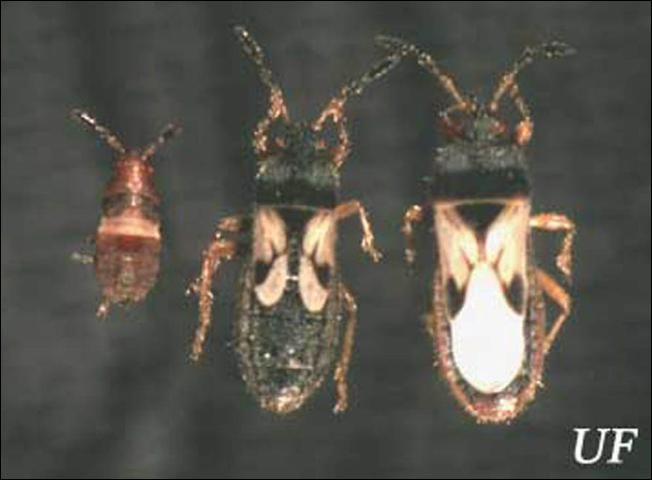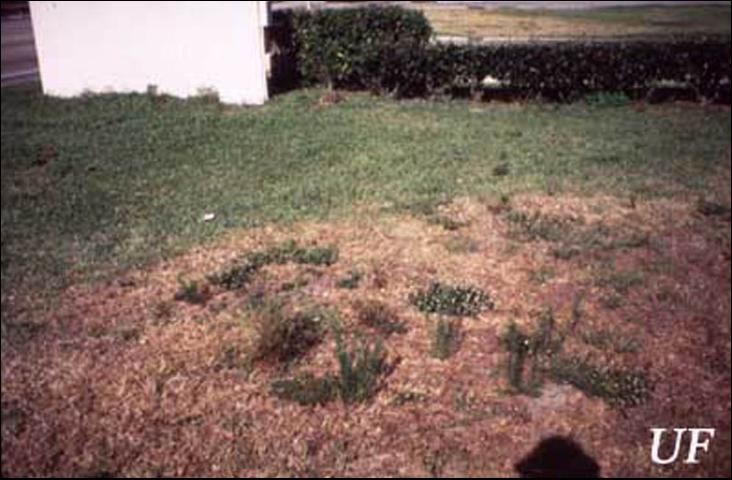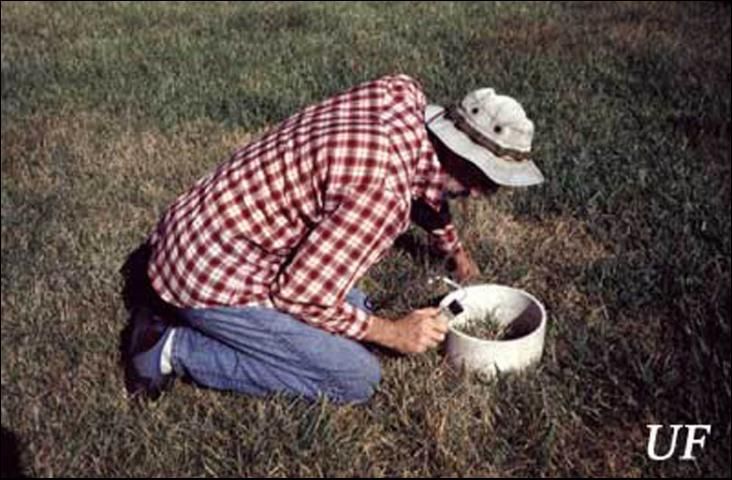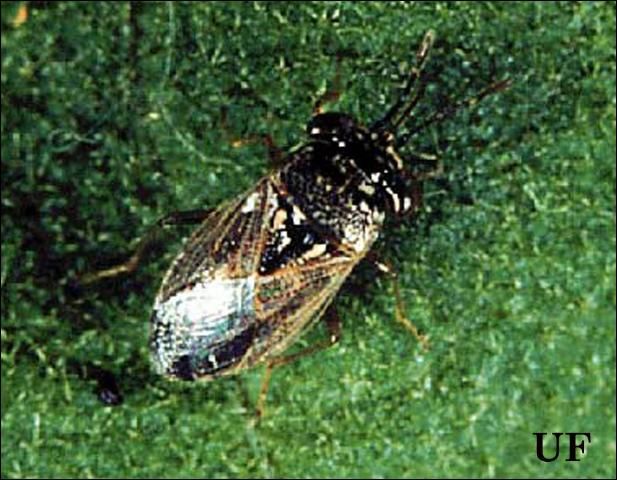The Featured Creatures collection provides in-depth profiles of insects, nematodes, arachnids and other organisms relevant to Florida. These profiles are intended for the use of interested laypersons with some knowledge of biology as well as academic audiences.
Introduction
The southern chinch bug, Blissus insularis Barber, is an insect pest of St. Augustinegrass, Stenotaphrum secundatum (Walt.) Kuntze, a turf and pasture grass grown throughout the southern United States. This tiny pest, rarely measuring over 6 mm (1/4 in) in length, causes millions of dollars in damage per year, as homeowners seek to control chinch bug outbreaks by applying insecticides and replacing damaged grass. For this reason, much research has focused on the development of a more economic and effective mode of control, although pesticide application remains the most popular method today.
The first reports of the southern chinch bug as an economic pest in the United States surfaced in Orange County, North Carolina in 1783 (Beyer 1924). Since that time, the genus Blissus has become a well-known pest throughout the southern United States, with scattered infestations in the western states. The southern chinch bug displays a preference for St. Augustinegrass, and this preference has elevated the southern chinch bug to the second most expensive plant feeding arthropod in Florida (Cherry and Nagata 1997; Kerr 1966). The southern chinch bug thrives during the warm, damp summer months, and infestations peak in early July (Kerr 1966). Although the southern chinch bug sometimes overwinters in a temporary dormant condition in north Florida, this insect typically remains active during the winter, sheltered around the roots and base of St. Augustinegrass. Thus, the southern chinch bug does not need to leave its feeding ground, and spring infestations often begin where the pest injury stopped the preceding season (Wilson 1929).
Distribution and Movement
Blissus insularis injury to St. Augustinegrass occurs throughout the southern states (Wilson 1929). Within Florida, the most severe damage occurs in the central and southern counties.
A population of Blissus insularis generally remains in the same area throughout the year (Kerr 1966). The southern chinch bug has retained the ability of flight, yet only a small proportion of the population appears to utilize flight as a means of dispersal. In most instances, a population of Blissus insularis moves from lawn to lawn within a neighborhood by walking from a heavily infested area to a fresh area to feed. During relocation, the population may cover over 400 feet in under an hour, an impressive achievement for such small creatures.
Description and Life Cycle
An adult female Blissus insularis deposits over 250 eggs on average in her lifetime (Kerr 1966). She may lay as little as four eggs a day, but she will oviposit for many continuous weeks (Kerr 1966; Wilson 1929). The female chinch bug deposits her eggs on St. Augustinegrass close to where the plant contacts the soil (Wilson 1929). During the summer months, the eggs hatch in six to 13 days, with an average incubation period of 11 days. This process can last a month or more during the winter.
The eggs are small and oval shaped, with a blunt end from which four small projections extend. The eggs begin as a pale white color and turn amber and eventually red before they hatch. The newly emerged nymphs resemble a smaller, wingless adult. The first nymphal instar is yellow. The color will change to red with a pale white band across the abdomen and finally to black with a similar white band as the insect progresses through its five nymphal instars.

Credit: R.H. Cherry, University of Florida
The adult form of the southern chinch bug has a black body measuring about 6 mm (1/4 in) in length (Wilson 1929). The wings are white with a black spot on the margins of the forewings. There are two forms of Blissus insularis: the long-winged form, in which the wings reach almost to the end of the abdomen, and the short-winged form, in which the wings extend about half the length of the abdomen. Studies regarding the length of the adult life span differ significantly, with averages ranging from 10 to 70 days; however, the mean life span in controlled conditions seems to be around 49 days (Kerr 1966; Wilson 1929).
Damage and Economic Significance
An infested lawn displays discolored patches, which are usually circular in shape. Injury typically occurs first in water-stressed areas along the edges of the lawn or where the grass is growing in full sunlight (Short and Black 1997; Short, Black, and McCarty 1995). St. Augustinegrass cultivated on high, dry, sandy or shell soil is especially vulnerable to southern chinch bug damage (Wilson 1929).

Credit: R.H. Cherry, University of Florida
Chinch bugs are not evenly distributed in an infestation site; rather, infected plots are scattered throughout the area (Kerr 1966). Within an infected plot, Blissus insularis distribute vertically from the turf thatch down into the upper organic layer of soil, usually to a depth of 38 mm (1½ in) below the surface. When Blissus insularis population levels are high, the chinch bugs are seen running over the grass blades. However, their main feeding activity continues to focus on the area of the plant between the turf thatch and the organic soil level.
The extent of injury of infected areas of St. Augustinegrass results from the gregarious feeding habits of the southern chinch bug (Wilson 1929). Large numbers of nymphs and adults gather at the base of one plant. As they feed, chinch bugs drain the sap from the grass until it withers, turning from a healthy green color to a brown-yellow color, and finally dies (Beyer 1924; Wilson 1929). Once the feeding group has killed one section of grass stolons, they move as a unit to the next adjacent stolon, continuing their destruction of the lawn.
Millions of dollars are spent annually in Florida to combat chinch bug outbreaks through application of insecticides, removal of weeds which grow among the infested and dead grass, and planting healthy grass once the chinch bug population has moved out of the area (Reinert 1978).
Monitoring and Diagnosis
Yellow or brownish spots of St. Augustinegrass do not necessarily denote a chinch bug infestation. Dehydration, root rot and other diseases, nematodes and various insect infestations may have similar symptoms (Short and McCarty 1995). To ensure proper treatment, homeowners must make a proper diagnosis of chinch bug infestation. To test for chinch bug presence, use the flotation method: remove the bottom of a metal coffee can and insert the can into the soil surrounding the discolored grass. Use a knife or shovel to dig the edges of the can down 3 inches into the soil. Fill the can with water continuously for five minutes. The chinch bugs trapped in the can will float to the top of the water. Repeat this method at least four times throughout the discolored area, concentrating on the perimeter of the injured spots, to ensure proper diagnosis (Short and Black 1997).

Credit: R.H. Cherry, University of Florida
Management
Specialists recommend integrated pest management to reduce the potential of chinch bug infestations on turfgrass. This method includes proper fertilization, irrigation, mowing, and pest control.
Cultural Control
Cultural practices, including proper mowing, fertilization, and irrigation, can greatly reduce the susceptibility of St. Augustinegrass to chinch bug infestations. St. Augustinegrass should be kept to a height of 3 to 4 inches to ensure a strong root system, which will increase the grass's tolerance against chinch bug infestations (Short and Black 1997). Lawns should be mowed frequently enough so that no more than 1/3 of the leaf blade is removed at each mowing. Furthermore, mowing with a sharpened blade will reduce the stress on the grass, thus making the lawn less susceptible to chinch bug outbreaks (McCarty and Cisar 1995).
Large applications of inorganic nitrogen fertilizers can cause rapid grass growth and heightened chinch bug susceptibility (Short and Black 1997). To reduce potential damage after fertilizing, use a water insoluble, time-release or multiple-application fertilizer (Short 1998).
Moisture stress in lawns also encourages chinch bug infestations (Short and Black 1997). To avoid over-watering, irrigate only after wilting begins, when the edges of the grass leaves start to curl. Less than an inch of water is usually sufficient to rewet the top 8 to 12 inches of the root zone (McCarty and Cisar 1995). Excessive water and fertilization can cause a thick layer of thatch to accumulate directly above the soil surface (Short and Black 1997). Thatch, a spongy mat of shoots, stems, and roots, provides a prime habitat for chinch bugs to feed and lay their eggs. If a significant layer of thatch covers a lawn, it may be removed mechanically by vertical mowing or power raking.
Chemical Control
Over the last century, specialists have recommended many different methods of chemical management for chinch bug infestations. Presently, the preferred method of management and control remains the application of insecticides to infected areas. However, isolated populations of Blissus insularis have developed resistance to insecticides (Nagata and Cherry 1999). Therefore, outbreaks require many insecticidal applications before the problem is eradicated, which makes the southern chinch bug an extremely difficult and expensive pest to manage.
Biological Control
In response to the development of resistance in Blissus insularis to chemical insecticides, researchers have focused on alternative methods of management. In the late 1960s and into the 1970s, researchers emphasized the importance of biological control to reduce chinch bug damage, and studies investigated the natural enemy complex of Blissus insularis (Reinert 1978; Kerr 1966). These studies identified many natural predators of the southern chinch bug. Reinert (1978) found that a bigeyed bug, Geocoris uliginosus, is the most numerous predator of the southern chinch bug in St. Augustinegrass. Other predators identified in this study included the striped earwig, Labidura riparia (Pallas), and two species of anthocorids, Xylocoris vicarius and Lasiochilus pallidulus. Kerr (1966) found that large populations of fire ants (Solenopsis sp.) also contribute to a reduction in Blissus insularis outbreaks.

Credit: University of Florida
However, the introduction of natural predators as the sole mean of control was not found to significantly reduce Blissus insularis populations, and researchers turned their attention towards the development of resistant grasses to ward off chinch bug damage. In 1973, the University of Florida and Texas A&M University released Floratam St. Augustinegrass as a chinch bug resistant cultivar of turfgrass (Busey 1990). Despite initial success, within twelve years isolated populations of Blissus insularis adapted genetically to Floratam. Today, studies continue to examine and develop chinch bug tolerant cultivars of St. Augustinegrass in order to limit chinch bug damage (Busey 1990; Busey and Zaenker 1992).
Selected References
Beyer AH. 1924. Chinch bug control on St. Augustine grass. Proceedings of the Florida State Horticultural Society 37: 216–219.
Busey P. 1990. Inheritance of host adaptation in the southern chinch bug (Heteroptera: Lygaeidae). Annals of the Entomological Society of America 83: 563–567.
Busey P, Zaenker EI. 1992. Resistance bioassay from southern chinch bug (Heteroptera: Lygaeidae) excreta. Journal of Economic Entomology 85: 2032–2038.
Cherry RH, Nagata RT. 1997. Ovipositional preference and survival of southern chinch bugs (Blissus insularis Barber) on different grasses. International Turfgrass Society Research Journal 8: 981–986.
Elliott ML, Simone GA. (1994). Take-all root rot of St. Augustinegrass. Gainesville: University of Florida Institute of Food and Agricultural Sciences. (no longer available online).
Kerr SH. 1966. Biology of the lawn chinch bug, Blissus insularis. Florida Entomologist 49: 9–18.
Krueger SR, Nechols JR, Ramoska WA. 1991. Infection of chinch bug, Blissus leucopterus leucopterus (Hemiptera: Lygaeidae), adults from Beauveria bassiana (Deuteromycotina: Hyphomycetes) conidia in soil under controlled temperature and moisture conditions. Journal of Invertebrate Pathology 58: 19–26.
McCarty LB, Cisar JL. (1995). Yearly calendar for St. Augustinegrass care and culture. Gainesville: University of Florida Institute of Food and Agricultural Sciences. (no longer available online).
Nagata RT, Cherry RH. 1999. Survival of different life stages of the southern chinch bug (Hemiptera: Lygaeidae) following insecticidal applications. Journal of Entomological Science 34: 126–131.
Reinert JA. 1978. Natural enemy complex of the southern chinch bug in Florida. Annals of the Entomological Society of America 71: 728–731.
Short D. (1998). Turf insect management suggestions (commercial & non-commercial). Gainesville: University of Florida Institute of Food and Agricultural Sciences. (no longer available online).
Short DE, Black RJ. (1997). Southern chinch bug management on St. Augustinegrass. Gainesville: University of Florida Institute of Food and Agricultural Sciences. (no longer available online).
Short DE, Black RJ, McCarty LB. (1995). Management of insects in lawns. Gainesville: University of Florida Institute of Food and Agricultural Sciences. (no longer available online).
Short DE, Castner JL. (1997). Turfgrass insects sheet 1. Gainesville: University of Florida Institute of Food and Agricultural Sciences. (no longer available online).
Wilson RN. 1929. The chinch bug in relation to St. Augustinegrass. USDA Circular No. 51.